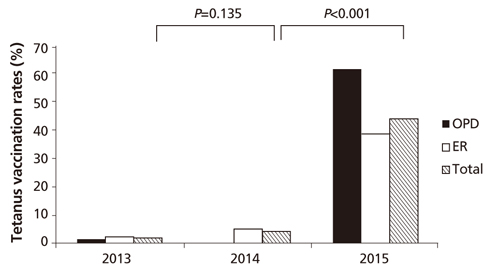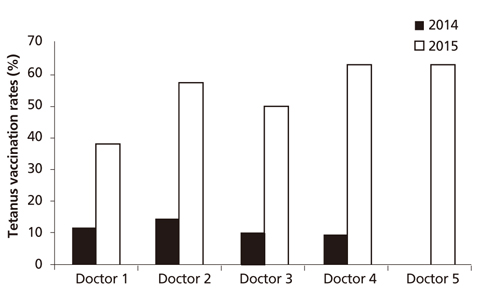J Korean Med Assoc.
2017 Jul;60(7):598-602. 10.5124/jkma.2017.60.7.598.
Improvement of tetanus prophylaxis by introducing an immunization information system
- Affiliations
-
- 1Department of Emergency Medicine, Hwacheon Health Center and County Hospital, Hwacheon, Korea.
- 2Department of Pediatrics, Kangwon National University School of medicine, Chuncheon, Korea.
- 3Department of Internal Medicine, Kangwon National University School of medicine, Chuncheon, Korea. legent@hanmail.net
- KMID: 2386601
- DOI: http://doi.org/10.5124/jkma.2017.60.7.598
Abstract
- Tetanus immunoglobulin (TIG) and tetanus vaccination are in general use for tetanus prophylaxis in patients with trauma based on their personal history of tetanus vaccinations. However, the conventional injection of only TIG has been used for tetanus prophylaxis due to difficulties in verifying the known vaccination histories of Korean patients. We evaluated the effect of introducing an immunization information system (IIS) on tetanus prophylaxis. TIG-injected trauma patients (≥20 years old) who were registered at a single hospital from January 1, 2013 to December 31, 2015 were enrolled in this study. IIS was introduced to all doctors in that hospital starting on January 1, 2015. IIS information and medical records were used to assess histories of tetanus vaccination and TIG administration. Comparisons were made between the number of tetanus and TIG shots (inadequate TIG administrations) given before and after the introduction of the IIS. The number of TIG-injected patients varied during the study period (362 in 2013, 387 in 2014, and 235 in 2015). The proportion of tetanus-vaccinated patients relative to TIG-injected patients increased from 2.21% in 2013 to 4.13% in 2014 and 44.26% in 2015 (P <0.001). The proportions of cases that were recorded as having received inadequate TIG administration decreased from 3.59% (13 of 362) in 2013 for patients with ≥3 tetanus vaccinations to 4.39% (17 of 387) in 2014 and 1.28% (3 of 235) in 2015 for the same group P = 0.043). The introduction of IIS could increase the number of patients with trauma who have proper tetanus vaccinations and decrease the number who undergo inadequate TIG administrations. The introduction of IIS can improve clinical practice in terms of enhancing proper tetanus prophylaxis for appropriate patients.
Keyword
MeSH Terms
Figure
Reference
-
1. Kretsinger K, Broder KR, Cortese MM, Joyce MP, Ortega-Sanchez I, Lee GM, Tiwari T, Cohn AC, Slade BA, Iskander JK, Mijalski CM, Brown KH, Murphy TV. Centers for Disease Control and Prevention. Advisory Committee on Immunization Practices. Healthcare Infection Control Practices Advisory Committee. Preventing tetanus, diphtheria, and pertussis among adults: use of tetanus toxoid, reduced diphtheria toxoid and acellular pertussis vaccine recommendations of the Advisory Committee on Immunization Practices (ACIP) and recommendation of ACIP, supported by the Healthcare Infection Control Practices Advisory Committee (HICPAC), for use of Tdap among health-care personnel. MMWR Recomm Rep. 2006; 55(RR-17):1–37.2. Ha YR, Goo HD, Kim SW, Jang SJ, Lee HS, Shim HS, Lee JW. Antitetanus antibody titers after toxoid injection. J Korean Soc Emerg Med. 1996; 7:202–206.3. Kim KC, Kim CH, Kim HJ, Jeon IS, Seo HK. Doctors’ prescription behavior for tetanus prophylaxis in wound management. Korean J Fam Med. 1996; 17:492–500.4. Kang JH. The need of Td vaccination according to the changes of tetanus and diphtheria immunity. J Korean Med Assoc. 2008; 51:127–136.
Article5. Social Security Information Service. Local health and medical information system [Internet]. Seoul: Social Security Information Service;2016. cited 2016 Dec 5. Available from: http://bit.ly/2a2wh59.6. Centers for Disease Control and Prevention. Tetanus surveillance: United States, 2001-2008. MMWR Morb Mortal Wkly Rep. 2011; 60:365–369.7. Kim HJ, Kang GH, Kim GW, Kim SC, Kim YS, Kim CH, Ahn HC, Oh SH, Yoon YS, Lee KH, Lee SW, Lee JB, Lee JW, Im TH, Chung JB, Cho SH, Cho KW, Cho JH, Cho JK, Choi MS, Hong ES, Lee YH. Korean Multicenter Study of Te tanus Antibody Titer (KoMUST). J Korean Soc Emerg Med. 2005; 16:667–676.8. Yoon YS, Kim EC, Lee WH, Chung SW, Yi JH, Park IC, Shim HS. Utility of Tetanos Quick Stick(R) test for selective tetanus prophylaxis. J Korean Soc Emerg Med. 2004; 15:95–101.9. Kang JH, Kim HB, Sohn JW, Lee SO, Chung MH, Cheong HJ, Choi YH, Choi JH, Choi JY, Choe HJ. Adult immunization schedule recommended by the Korean Society of Infectious Diseases, 2007. Infect Chemother. 2008; 40:1–13.
Article10. Duhem C, Dicato MA, Ries F. Side-effects of intravenous immune globulins. Clin Exp Immunol. 1994; 97:Suppl 1. 79–83.11. Kim JO. A clinical survey of tetanus. J Korean Surg Soc. 1975; 17:45–50.12. Kim SK, Choi SC, Cho TH. A clinical analysis on tetanus. J Korean Surg Soc. 1988; 34:17–23.13. Lee YH, Han DJ. A clinical analysis of tetanus. J Korean Surg Soc. 1991; 40:77–87.14. Lee HY, Moon JM, Min YI, Chun BJ, Koh YS, Lee BG. Clinical manifestations and prognostic factors for tetanus in the emergency department. J Korean Soc Emerg Med. 2007; 18:143–149.15. Lee JE, Lee SY. Evaluation of SD BIOLINE tetanus kit. Korean J Lab Med. 2007; 27:192–196.
Article16. Sohn YD, Lim KS, Choi WJ, Ahn JY, Kim W, Choi YB, Hong ES. Qualitative analysis of antitetanus antibody titers in Korean. J Korean Soc Traumatol. 2004; 17:27–36.17. Seo MJ. Evaluation of national immunization registry, 2002-2010 [Internet]. Cheongju: Korea Centers for Disease Control and Prevention;2011. cited 2017 Jul 1. Available from: http://cdc.go.kr/CDC/cms/content/mobile/34/12634_view.html.18. Korea Centers for Disease Control and Prevention. Disease and health integrated management system [Internet]. Cheongju: Korea Centers for Disease Control and Prevention;2016. cited 2016 Dec 5. Available from: http://is.cdc.go.kr/.19. Otsuka SH, Tayal NH, Porter K, Embi PJ, Beatty SJ. Improving herpes zoster vaccination rates through use of a clinical pharmacist and a personal health record. Am J Med. 2013; 126:832.
Article20. Stinchfield PK. Practice-proven interventions to increase vaccination rates and broaden the immunization season. Am J Med. 2008; 121:7 Suppl 2. S11–S21.
Article
- Full Text Links
- Actions
-
Cited
- CITED
-
- Close
- Share
- Similar articles
-
- Effect of a Single Tetanus Toxoid in Korean Adults with Low Tetanus Antibody Titers
- Recently Occurring Adult Tetanus in Korea: Emphasis on Immunization and Awareness of Tetanus
- Retention of the Mother and Child Health Handbook and Additional Immunization of Japanese Encephalitis and Tetanus Vaccine
- Adult immunization
- Immunoglobulins for Prophylaxis or Treatment of Infectious Diseases



